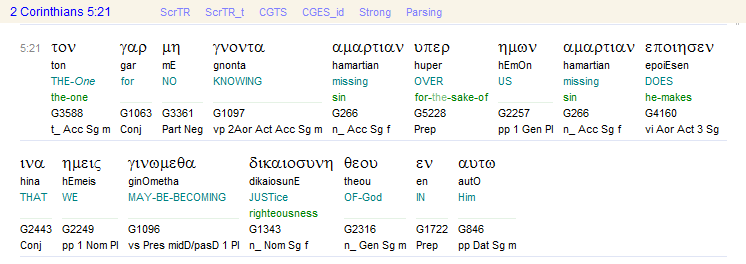No, maybe you don't comprehend all that well Johann - maybe you have something in your mind which inhibits you from understand Paul's Gospel? You and I have agree many many times that Christ "knew no sin" - we are not talking about the person of Christ who is without spot and blemish. We are talking about the nature of his sacrifice and what he became in God's eyes on that cross.
He, Jesus was made sin for you.
How many times did Christ die to sin?
And why was it necessary?
F2F
Jesus' sacrifice was a substitutionary atonement-He bore the penalty for humanity’s sin. This concept is rooted in the idea that Jesus, though sinless, took upon Himself the sins of the world to reconcile mankind to God.
Isaiah 53:5-6 (NKJV):
"But He was wounded for our transgressions, He was bruised for our iniquities; The chastisement for our peace was upon Him, and by His stripes we are healed. All we like sheep have gone astray; we have turned, every one, to his own way; and the Lord has laid on Him the iniquity of us all."
This prophecy illustrates Jesus' role as the suffering servant, taking upon Himself the sins of humanity and
bearing them as a sacrificial lamb.
Hebrews 9:28 (NKJV):
"So Christ was offered once to bear the sins of many. To those who eagerly wait for Him, He will appear a second time, apart from sin, for salvation."
Jesus’ sacrifice was once and for all, fulfilling the Old Testament sacrificial system and replacing the repeated sacrifices of the law with a perfect and eternal offering.
2 Corinthians 5:21 (NKJV):
"For He made Him who knew no sin to be sin for us, that we might become the righteousness of God in Him."
This verse encapsulates the nature of the atonement:
Jesus, the sinless one, was treated as if He were sin itself, though He remained personally without sin. This is the heart of imputed righteousness, where believers are made righteous through
Christ's sacrificial act.
In a judicial sense,
Jesus became the bearer of sin, which was the requirement for the atonement. He was not sinful by nature but was treated as sin, receiving the wrath and judgment that was due for humanity’s sins. This is reflected in Romans 3:25-26, where Jesus is presented as a propitiation (an atoning sacrifice) to satisfy the justice of God.
Isaiah 53:10 (NKJV):
"Yet it pleased the Lord to bruise Him; He has put Him to grief. When You make His soul an offering for sin, He shall see His seed, He shall prolong His days, and the pleasure of the Lord shall prosper in His hand."
God’s purpose in allowing Jesus to be bruised and crushed was to make His life an offering for sin. In God's eyes, Jesus was the perfect sacrificial lamb who fully satisfied God's justice.
Hebrews 10:12-14 (NKJV):
"But this Man, after He had offered one sacrifice for sins forever, sat down at the right hand of God... For by one offering He has perfected forever those who are being sanctified."
After completing the sacrificial work, Jesus is seen by God as the high priest and the perfect sacrifice. He now sits at the right hand of God, signifying that His sacrificial work is complete and accepted by the Father.
Philippians 2:8-9 (NKJV):
"And being found in appearance as a man, He humbled Himself and became obedient to the point of death, even the death of the cross. Therefore God also has highly exalted Him and given Him the name which is above every name."
Jesus' obedience in humbling Himself to death on a cross led God to highly exalt Him, demonstrating that in God’s eyes, Jesus is the exalted Lord and the Savior of humanity.
The nature of Jesus' sacrifice was substitutionary and atoning, making Him the bearer of humanity’s sin without being sinful Himself. In God's eyes, He became the perfect sacrifice who fulfilled the requirements of divine justice, and as a result, He is now exalted as both Lord and Savior, seated at the right hand of the Father.
Shalom and goodnight.
J.


